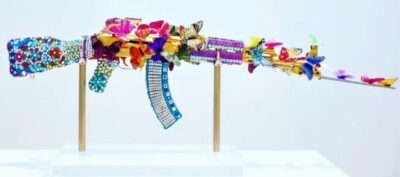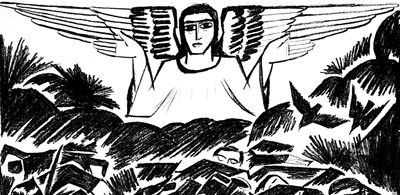Ed Ruscha: Agitpop for Bush
The US State Department has crowned Pop art legend, Ed Ruscha, as America’s representative at the 2005 Venice Biennale, allowing me the perfect opportunity to bring attention to the reader the ways in which art and politics are bound together. My contention has long been that all art is political, since it is the result not just of imagination but of human labor, and what field of human endeavor is more politicized than work? But approval or disapproval from society’s powerful institutions and individuals also politicizes art, and that couldn’t be any clearer than in the case of Ed Ruscha.
Ruscha (pronounced roo-SHAY) is one of the most enduring artists to have emerged from the Pop art explosion of the 1960’s. The word ‘Pop’ was first used in 1957 by a group of English artists and their associates who congregated at the Institute of Contemporary Arts in London. They took their inspiration from the modern urban environment, a banal showcase of excess and overproduction.
Pop really took root in America, where cities like New York and Los Angeles provided fertile ground for those artists who wanted to transform the common place and ‘low-brow’ into fine art. Pop was an aesthetic born from all things commercial, distilling mass media icons with images taken directly from capitalism’s consumer paradise – automobile design, advertising, product packaging, comics and the like.

Pop was intrinsically political since it dealt with mass media and America’s dominant commercial culture, yet artists like Warhol, Robert Indiana, Mel Ramos, and Tom Wesselmann were more interested in having their works mirror society than critiquing it. Some Pop artists like Edward Kienholz, Robert Rauschenberg and Roy Lichtenstein were less timid about making overt political statements in their art, and it was this strain of Pop that had a direct influence upon me. In fact, it was a nod to Mr. Lichtenstein’s use of comic strip images as the basis for his paintings that led me to produced my 1980 silkscreen, Nuclear War?!… There Goes My Career!
Having been born and raised in Los Angeles, I’ve obviously been influenced by Pop sensibilities, if only by osmosis. So I was quite interested when photographer James W. Bailey sent me an e-mail concerning the US State Department’s approval of fellow LA artist, Ed Ruscha. Bailey wrote an article concerning Ruscha fronting for the State Department and submitted it to the Los Angeles Times and the LA Weekly (we’ll see if they publish the piece).
Bailey chose to submit his Ruscha commentary to me, because in his words: “It only seems appropriate to me that someone in LA raise some of the questions I’m asking.” So here in its entirety is James W. Bailey’s article, Code Red Alert: The U.S. State Department Officially Approves Artist Ed Ruscha for International Exhibition at the Venice Biennale.
“When upper management in the US Department of State meets behind closed doors, it’s normally for the purpose of developing the spin of the day to continue to advance the war theory of weapons of mass destruction; but when the little known Bureau of Educational and Cultural Affairs appoints high ranking curators and museum directors to meet behind closed doors, their postmodern art job is to emerge with an American artist weapon of mass appeal (Ed Ruscha) to participate in the 2005 Venice Biennale. The State Department controlled process for deciding the participating American artist for the 2005 Venice Biennale was a screw-up that only a government agency that believes in “nation building” could conceive.
A federal law, the Fulbright-Hays Act, mandates that the State Department provide oversight of American participation in a handful of prestigious international artistic and cultural events, including the Venice Biennale. Until recently, the process of selecting an artist was orchestrated by the Fund for US Artists at Overseas Exhibitions.
In the past the National Endowment for the Arts would convene a panel of insider art professionals who were tasked with reviewing curatorial proposals submitted in response to an open call for submissions. The Pew Charitable Trusts and the Rockefeller Funds kicked in the money to support the chosen project, with a little boot offered by the State Department.
But the public/private partnership collapsed in late 2003 when the private funders, citing a realignment of funding priorities, pulled out. The State Department, once again caught off guard because of bad CIA intel, didn’t know what was happening or what to do. Thus, their undemocratic solution: Have a select group of non-controversial pro-American art priests go into a closed door session and select a non-controversial pro-American pop artist whose minimalist work is subject to open-ended conversations that will never touch on any issues regarding America’s arrogant attitude as exemplified by its foreign policy – and with specifically no references whatsoever to its “War on Terrorism.”
And to further assure that the message of the artist stays comfortably within State Department approved guidelines regarding the content of curatorial messages, the selected artist, Ed Ruscha, was allowed to choose his own curator (Linda Norden, associate curator of contemporary art at Harvard’s Fogg Art Museum), a Venice Biennale first for America’s official representative.
Needless to say that this whitewashed arrangement will not result in a controversial installation by Ruscha in which he digitally photographs performance actors/artists playing the role of military interrogators flushing the Koran down a toilet while others dressed as American soldiers wail on Muslim captives.
No, we’ll be safely treated to innocent and non-provocative words and phrases painted on canvasses like, WHO ME? or ART = MONEY = FAME, or SWEET, and other deep stuff like that that wears a bullet proof critical vest – the Minimalist postmodern art fanatics love Ruscha and naturally they’re not about to criticize his government sanctioned appearance in Venice; the worst we’ll hear and read is “he was a safe choice.” Safe indeed.
Safe is what you’ll always get when your government gets in the business of proffering art to the world; and safer still is what you must get when dangerous times compel quiet artistic acquiescence to the pro-war-on-terrorism party line.
Our government’s position during this so-called “War on Terrorism” is that we all just shut up, sit down and do what we’re told to do. Our government has made it easy for us to know when to comply by issuing its daily Homeland Security Codes in Minimalist colors and words RED = SEVERE, ORANGE = HIGH, YELLOW = ELEVATED, BLUE = GUARDED and GREEN = LOW.
It comes as no surprise that the U.S. Statement Department has enthusiastically endorsed a minimalist word artist like Ed Ruscha as the official American artist to represent the United States of America at the 2005 Venice Biennale. Maybe the man behind the curtain in our government will lower the national security alert lever to GREEN so as to encourage all of us compliant Americans to trip over to Italy this summer to see what profound words of encouragement that Ruscha has painted for our cultural edification and amusement.
Or more likely, once again we’ll find ourselves this summer being urged to stay inside because of the mandatory Code Red Alert – and perhaps that’s not a bad thing because anytime your government issues an official imprimatur on a specific artist from a particular school of art, red flags ought to be going up everywhere.
Maybe we should just comply by staying at home this summer and thinking very deeply about what those Code Red Alerts and government sanctioned artists really mean for the cultural future of our country.”



